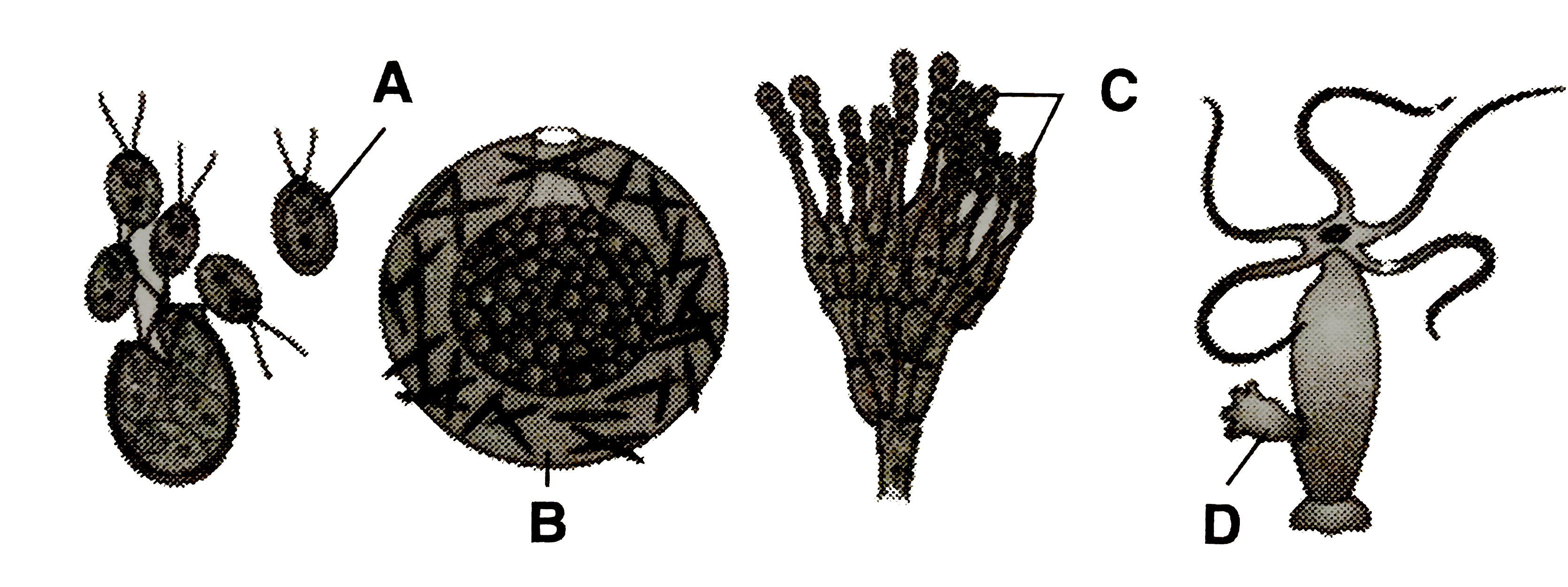Asexual reproductive structure of Hydra is :
Gemmule
Bud
Conidia
None of these
The correct Answer is:B
Step-by-Step Solution:
1. Understanding Asexual Reproduction:
- Asexual reproduction involves a single parent organism producing offspring without the fusion of gametes. The offspring are genetically and morphologically identical to the parent, referred to as clones.
2. Identifying Asexual Reproductive Structures:
- Common asexual reproductive structures include:
- Zoospores
- Buds
- Gemmules
- Conidia
3. Evaluating the Options:
- Gemmules: These are reproductive structures found in sponges, not in Hydra. Therefore, this option is incorrect.
- Buds: In Hydra, asexual reproduction occurs through a process called budding, where a small outgrowth (bud) forms on the parent organism.
- Conidia: This structure is associated with fungi and is not relevant to Hydra. Thus, this option is also incorrect.
4. Understanding the Budding Process:
- In Hydra, a bud forms as an outgrowth from the parent. Initially, the bud is attached to the parent but eventually detaches to become a new individual.
5. Conclusion:
- The correct answer to the question "Asexual reproductive structure of Hydra is:" is Buds.
- Asexual reproduction involves a single parent organism producing offspring without the fusion of gametes. The offspring are genetically and morphologically identical to the parent, referred to as clones.
- Common asexual reproductive structures include:
- Zoospores
- Buds
- Gemmules
- Conidia
- Gemmules: These are reproductive structures found in sponges, not in Hydra. Therefore, this option is incorrect.
- Buds: In Hydra, asexual reproduction occurs through a process called budding, where a small outgrowth (bud) forms on the parent organism.
- Conidia: This structure is associated with fungi and is not relevant to Hydra. Thus, this option is also incorrect.
- In Hydra, a bud forms as an outgrowth from the parent. Initially, the bud is attached to the parent but eventually detaches to become a new individual.
- The correct answer to the question "Asexual reproductive structure of Hydra is:" is Buds.
Topper's Solved these Questions
- REPRODUCTION IN ORGANISMSBOOK - MODERN PUBLICATIONCHAPTER - REPRODUCTION IN ORGANISMSEXERCISE - REVISION EXERCISES. (QUESTION FROM CBSE EXAMINATIONS :)
9 Videos
- REPRODUCTION IN ORGANISMSBOOK - MODERN PUBLICATIONCHAPTER - REPRODUCTION IN ORGANISMSEXERCISE - REVISION EXERCISES (SHORT ANSWER TYPES QUESTIONS )
31 Videos
- REPRODUCTION IN ORGANISMSBOOK - MODERN PUBLICATIONCHAPTER - REPRODUCTION IN ORGANISMSEXERCISE - REVISION EXERCISES. MULTIPLE CHOICE QUESTIONS (MCQS) (CHOOSE THE CORRECT ANSWER )
14 Videos
- PRINCIPLES OF INHERITANCE AND VARIATIONBOOK - MODERN PUBLICATIONCHAPTER - PRINCIPLES OF INHERITANCE AND VARIATIONEXERCISE - CHAPTER PRACTICE TEST section-e(Long answer type question)
1 Videos
- REPRODUCTIVE HEALTH BOOK - MODERN PUBLICATIONCHAPTER - REPRODUCTIVE HEALTH EXERCISE - CHAPTER PRACTICE TEST (SECTION D (LONG ANSWER QUESTION))
2 Videos
Similar Questions
Knowledge Check
In sponges, asexual reproductive structure is
AEndogenous buddingBExogenous buddingCConidiaDZoosporesIdentify A and D in figure gives below showing asexual reproductive structures:
 AA. Zoospores of Chlamydomonas, B. Gemmules in sponges, C. Conidia of Penicilluim, D. Buds in HydraBA. Zoospores of Chlamydomonas, B.Conidia of Penicilluim, C. Buds in Hydra , D. Gemmules in spongesCA. Gemmules in sponges, B. Zoospres of Chlamydomons, C. Conidia of Penicilluim, D. Buds is HydraDA.Conidia of Penicilluim, B. Zoospres of Chlamydomons, C. Buds is Hydra , D. Gemmules in sponges
AA. Zoospores of Chlamydomonas, B. Gemmules in sponges, C. Conidia of Penicilluim, D. Buds in HydraBA. Zoospores of Chlamydomonas, B.Conidia of Penicilluim, C. Buds in Hydra , D. Gemmules in spongesCA. Gemmules in sponges, B. Zoospres of Chlamydomons, C. Conidia of Penicilluim, D. Buds is HydraDA.Conidia of Penicilluim, B. Zoospres of Chlamydomons, C. Buds is Hydra , D. Gemmules in spongesIdentify Ato D in given diagrams showing asexual reproductive structure:
 AA - Zoogamete, B - Conidia, C - Bud, D - GemmuleBA - Zoospore, B - Conidia, C - Bud, D - GemmuleCA-Zoospore, B - Conidiosporangium, C - Bud, D - GemmuleDA-Aplanospore, B - Conidia, C - Bud, D - Gemmule
AA - Zoogamete, B - Conidia, C - Bud, D - GemmuleBA - Zoospore, B - Conidia, C - Bud, D - GemmuleCA-Zoospore, B - Conidiosporangium, C - Bud, D - GemmuleDA-Aplanospore, B - Conidia, C - Bud, D - Gemmule
A represents asexual reproductive structures produced in penicillium Identify A.
View SolutionAsexual reproduction is :
View SolutionAsexual reproduction is :
View SolutionIdentify A to D in given figures showing asexual reproductive structure

View SolutionMost common special asexual reproductive structure seen in members of algae is
View Solution
